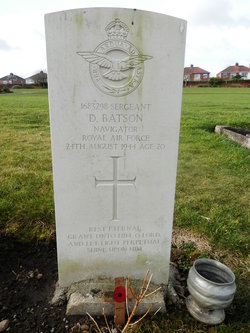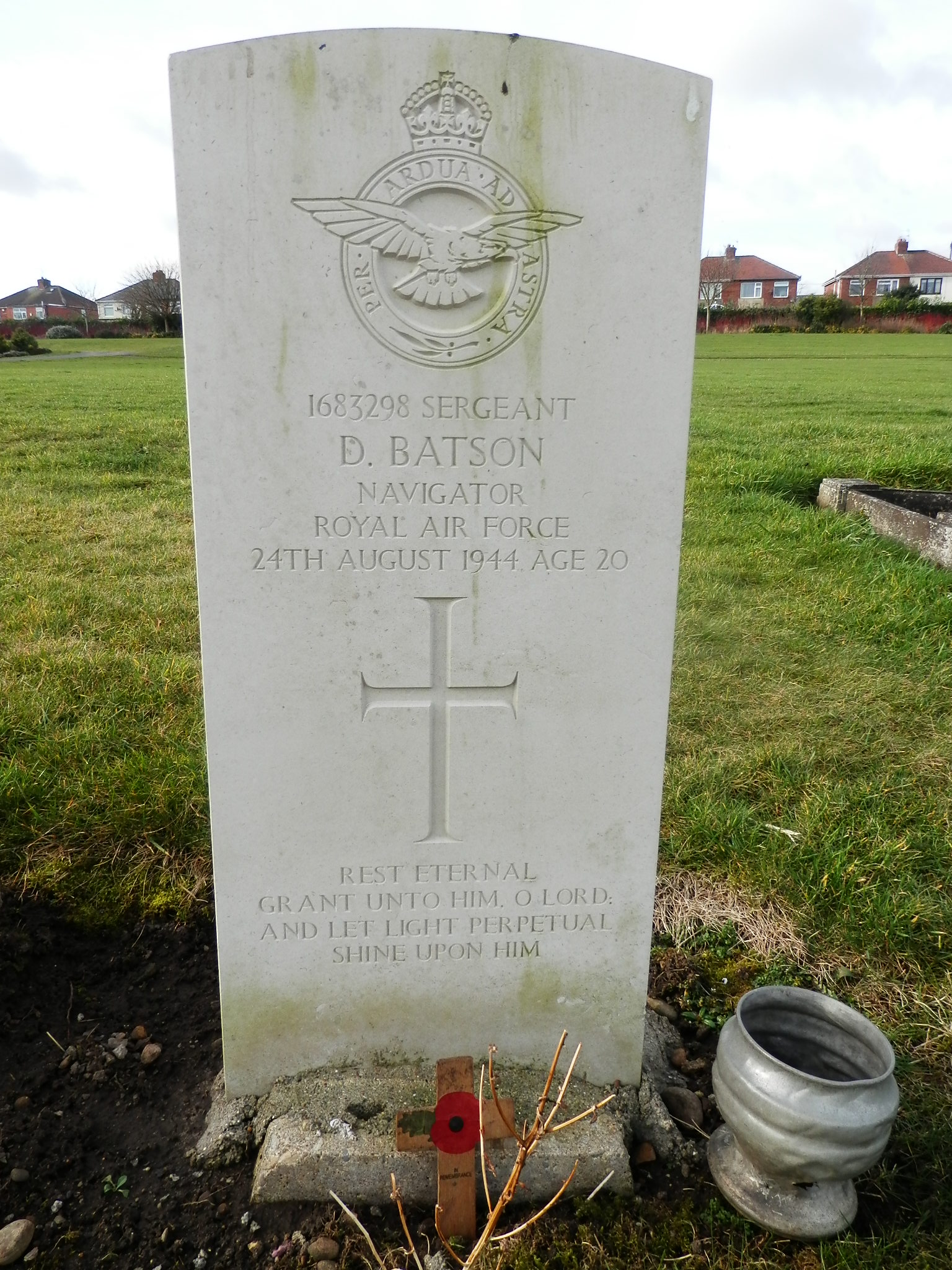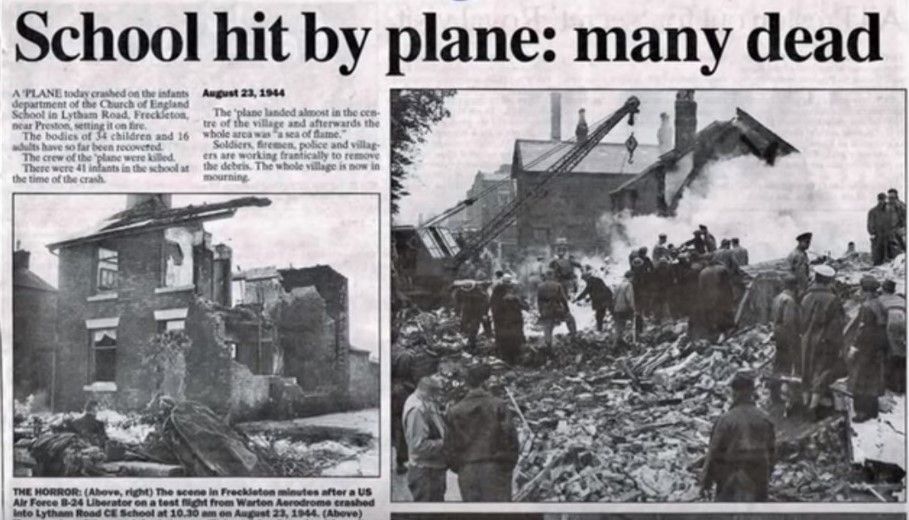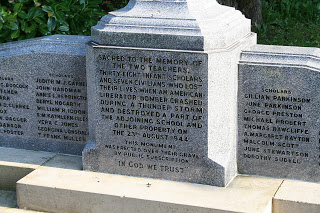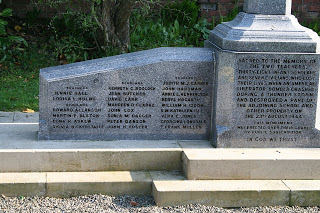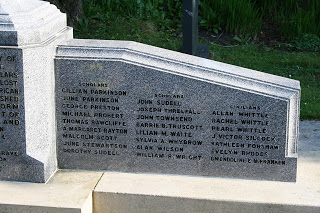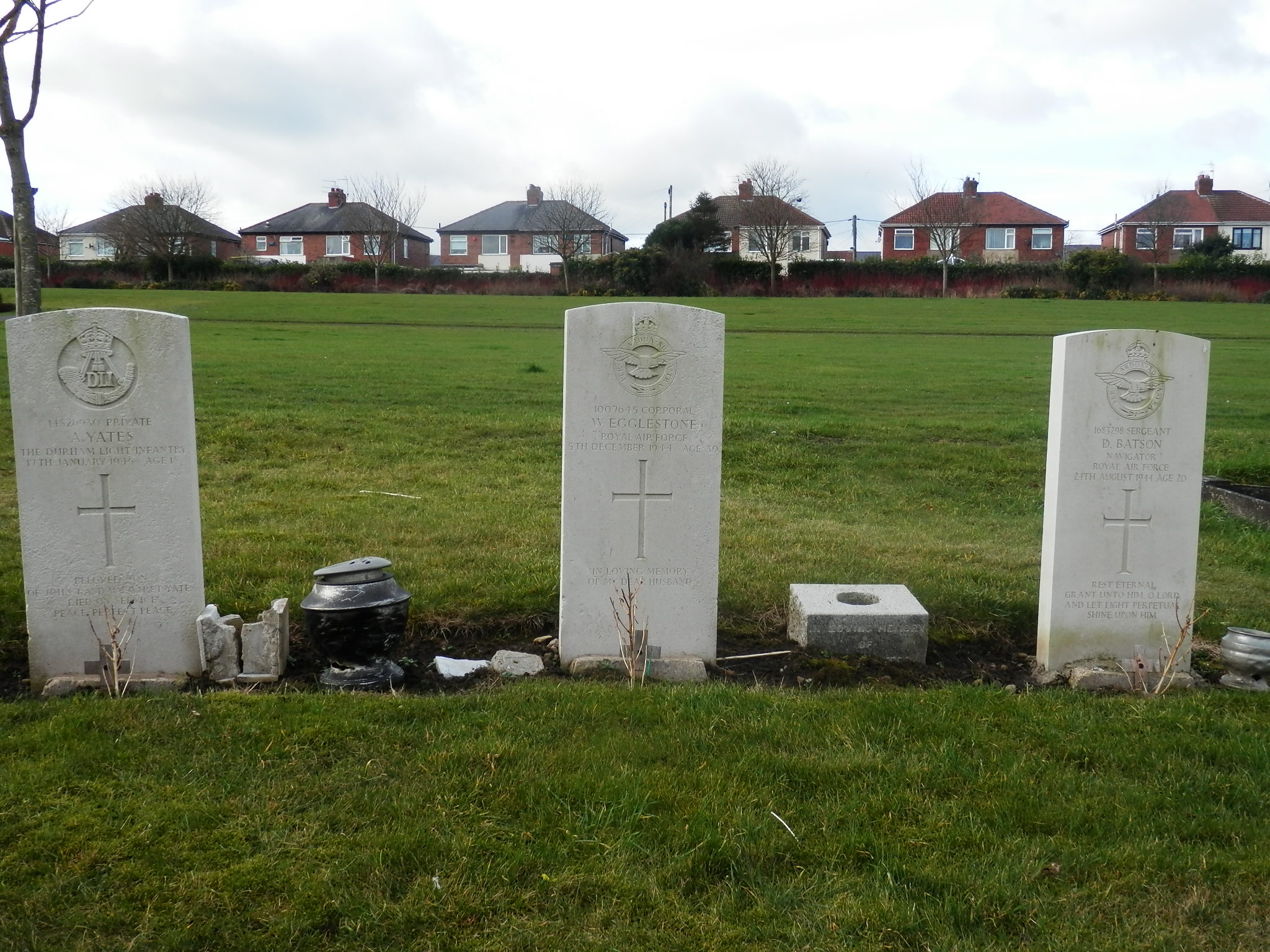★★★★★★★★★★★★★★★★★★★★★★★★★
ROYAL AIR FORCE VOLUNTEER RESERVE (RAFVR)
SERGEANT/NAVIGATOR
Service #1683298
Killed In Action
FRECKLETON DISASTER
TY to FGraver Dimitrios Corcodilos for the updated burial information and photos of Sgt. Batson's grave - it is greatly appreciated.
Naval Sergeant Douglas Batson was the son of Joseph and Elizabeth; he was one of 61 persons killed in the Freckleton Disaster; while the majority of the victims died instantly, Sergeant Batson lingered for one day, dying of his injuries on the 24th of August 1944.
The tragic event occurred when an American U.S. Army Air Force Consolidated B - 24 Liberator crashed into the village of Freckleton, located in Lancashire County, England. 38 children and 23 adults people were killed when an infant school, a cafe and three homes were destroyed.
Storms came up suddenly that day, and the two B - 24s already in air were called back to ground, due to weather warnings. However, by the time the orders to return to ground had been issued, winds were already at 60 mph, flash flooding was being reported in Blackpool, and water spouts were appearing the Ribble Estuary.
1st Lieutenant John Bloemendahl, the pilot of the second aircraft - the "Classy Chassis II" - reported that he was aborting landing at the last moment and would 'circle round again'. Minutes later, the aircraft struck Freckleton, east of the airfield.
It was determined that the aircraft's wings were almost vertical when it scraped the treetops, and then impacted with the edge of a building. One of the wings was immediately sheared off, and continued along the ground into shrubs and hedges; the 25 - ton aircraft's fuselage demolished three homes and the "Sad Sack" Cafe, before crossing the road and bursting into flames. The fuselage then struck the infant wing of Holy Trinity School, its' fuel igniting a sea of flames.
There was much discussion as to whether the plane had been struck by lightning, whether it was the weather, or whether it could be deemed pilot error - eventually, it was listed as of unknown reason. Some did believe - and continue to this day to believe - that the American pilot had not been fully trained to deal with the sudden changes in British weather; indeed, an English shower can quickly go to a deadly storm, as anyone with connections to the country will verify.
Possibly one positive thing that did come from the tragedy, as a matter of fact, is that American pilots were re-trained from that moment on, being warned of how quickly the 'soft rains' of England can spiral into something much worse.
Sergeant Batson was a member of the RAF Volunteer Reserve, and was a customer inside the Sad Sack that day. His age is noted in records as twenty, and his parents were a Joseph and Elizabeth Batson of Dunham. No other personal information seems to be available, but I am continuing to trace whatever leads that come up.
While many of the victims were buried in a mass grave, there is verification that Mr. Batson was buried at Duncombe Cemetery, Ferryhill.
He, like the other victims, is memorialized at multiple Freckleton Disaster memorial sites, as well as being listed in the Commonwealth Rolls of the Dead, located at Westminster Abbey.
★★★★★★★★★★★★★★★★★★★★★★★★★★★★
"These heroes are dead. They died for liberty - they died for us. They are at rest. They may or may not sleep in the land they made free, under the flag they rendered stainless, under the solemn pines, the sad hemlocks, the tearful willows, and the embracing vines. They sleep beneath the shadows of the clouds, careless alike of sunshine or of storm, each in the windowless Place of Rest. Earth may run red with other wars - they are at peace. In the midst of battle, in the roar of conflict, they found the serenity of death. I have one sentiment for soldiers living and dead: cheers for the living; tears for the dead." ~Robert G. Ingersoll
★★★★★★★★★★★★★★★★★★★★★★★★★
ROYAL AIR FORCE VOLUNTEER RESERVE (RAFVR)
SERGEANT/NAVIGATOR
Service #1683298
Killed In Action
FRECKLETON DISASTER
TY to FGraver Dimitrios Corcodilos for the updated burial information and photos of Sgt. Batson's grave - it is greatly appreciated.
Naval Sergeant Douglas Batson was the son of Joseph and Elizabeth; he was one of 61 persons killed in the Freckleton Disaster; while the majority of the victims died instantly, Sergeant Batson lingered for one day, dying of his injuries on the 24th of August 1944.
The tragic event occurred when an American U.S. Army Air Force Consolidated B - 24 Liberator crashed into the village of Freckleton, located in Lancashire County, England. 38 children and 23 adults people were killed when an infant school, a cafe and three homes were destroyed.
Storms came up suddenly that day, and the two B - 24s already in air were called back to ground, due to weather warnings. However, by the time the orders to return to ground had been issued, winds were already at 60 mph, flash flooding was being reported in Blackpool, and water spouts were appearing the Ribble Estuary.
1st Lieutenant John Bloemendahl, the pilot of the second aircraft - the "Classy Chassis II" - reported that he was aborting landing at the last moment and would 'circle round again'. Minutes later, the aircraft struck Freckleton, east of the airfield.
It was determined that the aircraft's wings were almost vertical when it scraped the treetops, and then impacted with the edge of a building. One of the wings was immediately sheared off, and continued along the ground into shrubs and hedges; the 25 - ton aircraft's fuselage demolished three homes and the "Sad Sack" Cafe, before crossing the road and bursting into flames. The fuselage then struck the infant wing of Holy Trinity School, its' fuel igniting a sea of flames.
There was much discussion as to whether the plane had been struck by lightning, whether it was the weather, or whether it could be deemed pilot error - eventually, it was listed as of unknown reason. Some did believe - and continue to this day to believe - that the American pilot had not been fully trained to deal with the sudden changes in British weather; indeed, an English shower can quickly go to a deadly storm, as anyone with connections to the country will verify.
Possibly one positive thing that did come from the tragedy, as a matter of fact, is that American pilots were re-trained from that moment on, being warned of how quickly the 'soft rains' of England can spiral into something much worse.
Sergeant Batson was a member of the RAF Volunteer Reserve, and was a customer inside the Sad Sack that day. His age is noted in records as twenty, and his parents were a Joseph and Elizabeth Batson of Dunham. No other personal information seems to be available, but I am continuing to trace whatever leads that come up.
While many of the victims were buried in a mass grave, there is verification that Mr. Batson was buried at Duncombe Cemetery, Ferryhill.
He, like the other victims, is memorialized at multiple Freckleton Disaster memorial sites, as well as being listed in the Commonwealth Rolls of the Dead, located at Westminster Abbey.
★★★★★★★★★★★★★★★★★★★★★★★★★★★★
"These heroes are dead. They died for liberty - they died for us. They are at rest. They may or may not sleep in the land they made free, under the flag they rendered stainless, under the solemn pines, the sad hemlocks, the tearful willows, and the embracing vines. They sleep beneath the shadows of the clouds, careless alike of sunshine or of storm, each in the windowless Place of Rest. Earth may run red with other wars - they are at peace. In the midst of battle, in the roar of conflict, they found the serenity of death. I have one sentiment for soldiers living and dead: cheers for the living; tears for the dead." ~Robert G. Ingersoll
Inscription
1683298
SERGEANT
D. BATSON
NAVIGATOR
ROYAL AIR FORCE
24TH AUGUST 1944 AGE 20
REST ETERNAL
GRANT UNTO HIM, O LORD:
AND LET LIGHT PERPETUAL
SHINE UPON HIM
